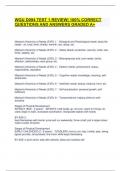WGU D094 TEST 1 REVIEW| 100% CORRECT
QUESTIONS AND ANSWERS GRADED A+
Maslow's Hierarchy of Needs LEVEL 1 - Biological and Physiological needs: basic life
needs - air, food, drink, shelter, warmth, sex, sleep, etc.
Maslow's Hierarchy of Needs LEVEL 2 - Safety Needs: protection, security, order, law,
limits, stability, etc.
Maslow's Hierarchy of Needs LEVEL 3 - Belongingness and Love needs: family,
affection, relationships, work group, etc.
Maslow's Hierarchy of Needs LEVEL 4 - Esteem needs: achievement, status,
responsibility, reputation
Maslow's Hierarchy of Needs LEVEL 5 - Cognitive needs: knowledge, meaning, self-
awareness
Maslow's Hierarchy of Needs LEVEL 6 - Aesthetic needs: beauty, balance, form, etc.
Maslow's Hierarchy of Needs LEVEL 7 - Self-actualization: personal growth, self-
fulfillment
Maslow's Hierarchy of Needs LEVEL 8 - Transcendence: helping others to self-
actualize
Stages of Physical Development
INFANCY (Birth - 2 years) - INFANTS: hold heads up, roll over, reach for things, sit,
crawl, begin to walk, increased coordination, manipulate objects with hands
BY AGE 2:
feed themselves with hands, jump and run awkwardly, throw a ball, pull a zipper down,
make a tower of blocks
Stages of Physical Development
EARLY CHILDHOOD (2 - 6 years) - TODDLERS: love to run, hop, tumble, play, swing,
jigsaw puzzles, string beads, fine motor skills begin developing
BY AGE 4: print name, eats with utensils, dress and undress self
,Stages of Physical Development
MIDDLE CHILDHOOD (6 - 10 years) - slow, steady weight gain, speed and
coordination improve, begin organized sports
BY AGE 10: improved writing skills, engages in organized sports
Stages of Physical Development
ADOLESCENCE (10 - 18 years) - weight and heigh increase, girls typically begin
puberty before boys
BY LATE ADOLESCENCE:
boys are typically taller and more muscular than girls of the same age, girls' physical
growth slows, boys may grow into early adulthood
Piaget's Stages of Cognitive Development
STAGE 1 - SENSIORIMOTOR
- Birth to 2 years
- Babies = 5 senses and gross motor skills. Objective permeance by the end of the
stage
Piaget's Stages of Cognitive Development
STAGE 2 - PREOPERATIONAL
- 2 to 7 years
- Pre = Preschoolers = illogical, egocentric
Piaget's Stages of Cognitive Development
STAGE 3 - CONCRETE OPERATIONAL
- 7 to 11 years
- Grade Schoolers = Factual. They like concrete hands-on activities
Piaget's Stages of Cognitive Development
STAGE 4 - FORMAL OPERATIONAL
- 11 years and older
- Think abstractly and use hypotheses
The Basic Principles of Piaget's Theory - - Assimilation: New information comes in and
it is the same/similar to previous information. You just add to your scheme. The s in
assimilation stands for the same.
- Accommodation: New information comes in and is different than previous schemes.
You have to change your scheme. The c in accommodation stands for change.
MKO (Vygotsky) - More Knowledgeable Other (MKO) - According to Vygotsky we learn
through socialization with a More Knowledgeable Other (an adult, older child, or more
knowledgeable peer).
, Zone of Proximal Development (Vygotsky) - Zone of Proximal Development - The just
right place to teach a child. Not too hard, not too easy. They need a little support
(scaffolding) from the teacher. Think of first and second grade reading groups - these
groups are placing the students in their zone of proximal development.
Scaffolding n(Vygotsky) n- n nScaffolding n- nSupporting nthe nstudents nin ntheir nlearning.
nAsking nleading nquestions, nproviding nhints, nclues, nwithout ndirectly ngiving nstudents nthe
nanswer.
3 nTypes nof nSpeech n(Vygotsky) n- n n1. nSocial nSpeech n- nWhen nwe ntalk nto nothers
2. nPrivate nSpeech n- nWhen nwe ntalk nout nloud nto nourselves. nThis noccurs nbetween nages n3-
7. nA nchild ncannot nspeak nquietly ninside nhis/her nhead.
3. nSilent nInner nSpeech n- nWhen nwe ntalk ninside nour nhead. nNo none ncan nhear nour nprivate
ninner nthoughts.
Erickson's nStages nof nPsychosocial nDevelopment
TRUST nVS. nMISTRUST n- n n(birth nto n1 nyear) n- nLearning nthat na ncare ngiver nwill nmeet nthe
nbaby's nneeds
Erickson's nStages nof nPsychosocial nDevelopment
AUTONOMY nVS. nSHAME nAND nDOUBT n- n n(1 nto n3 nyears) n- nThe nme ndo nstage n- nPick nthis
nchoice nwhen nthe nchild ninsists non ndoing nsomething nin nthe nscenario.
Erickson's nStages nof nPsychosocial nDevelopment
INITIATIVE nVS. nGUILT n- n n(3 nto n6 nyears) n- nPick nthis nchoice nwhen nthe nscenario nmentions
nexploration.
Erickson's nStages nof nPsychosocial nDevelopment
INDUSTRY nVS. nINFERIORITY n- n n(6 n- n12 nyears n- ngrade nschoolers) nAt nthis nstage nwe
nwant nto nprovide npositive nreinforcement nto nstudents. nFocus non ntheir nstrengths. nHelp
neveryone nto nbe nsuccessful.
Erickson's nStages nof nPsychosocial nDevelopment
IDENTITY nVS. nROLE nCONFUSION n- n n(12 n- n18 nyears n-middle nand nhigh nschoolers) nThe
nadolescents nis ntrying nto nfigure nout nwhat nthey nwant nto ndo nwith ntheir nlives.
Erickson's nStages nof nPsychosocial nDevelopment
INTIMACY nVS. nISOLATION n- n n(20s nthrough nearly n40s)- nFinding na npartner nand nfriends.
nHaving npeople, nyou ncan ncount non nand nnot nfeeling nalone.
Bandura's nTheory nof nObservational nand nModeling nLearning n- n n- nSocial nLearning n=
nSocial nCognitivism
- nModeling nand nEmulation n- n"Bobo nDoll nExperiment" n- n"Monkey nsee, nMonkey ndo" n- nYou
nwatch nsomeone nmodel na nbehavior nand nthen ntry nand nemulate n(copy) nit.




